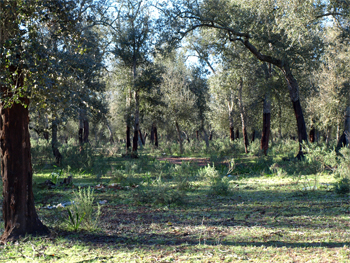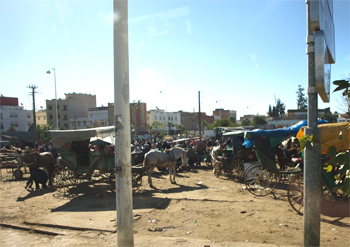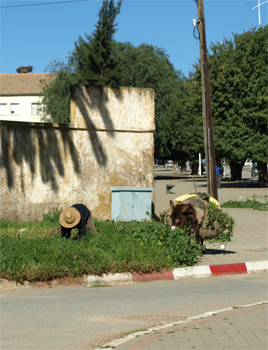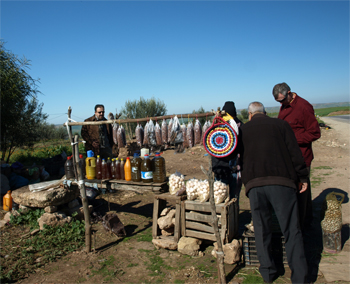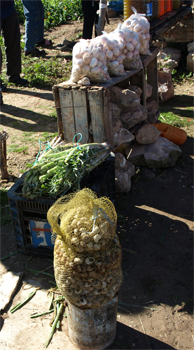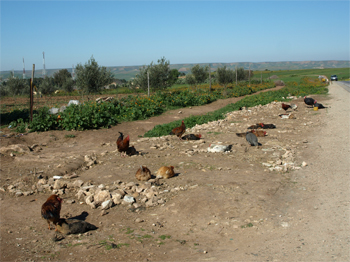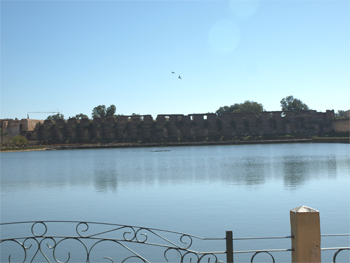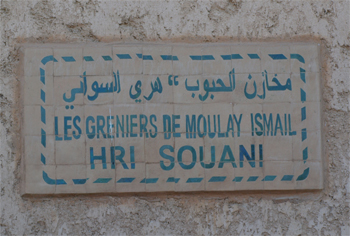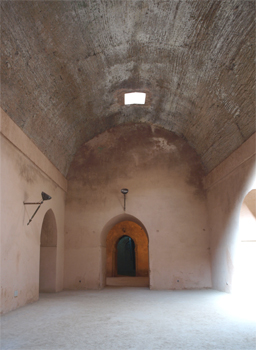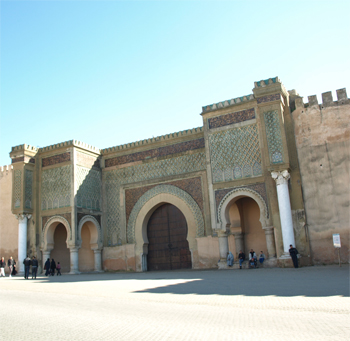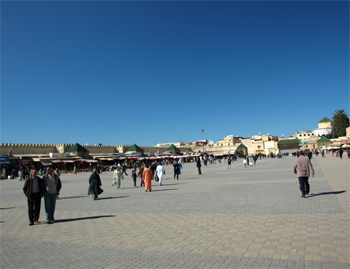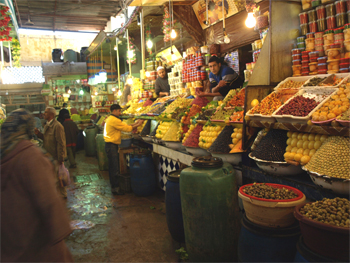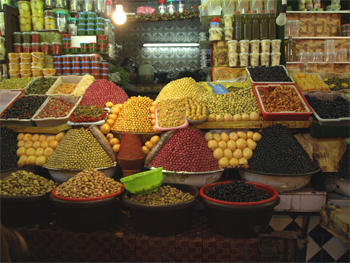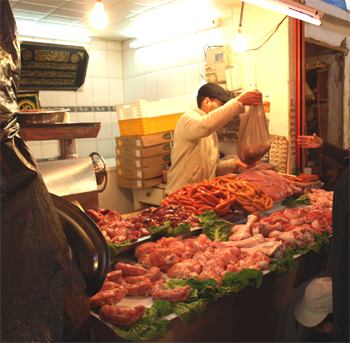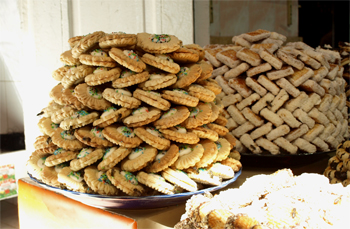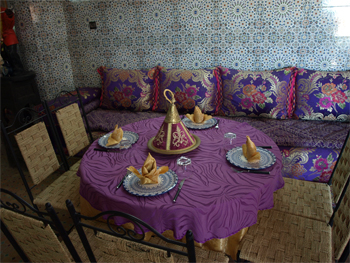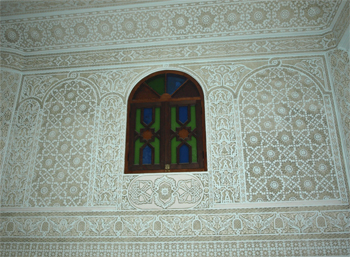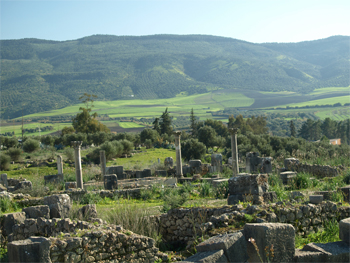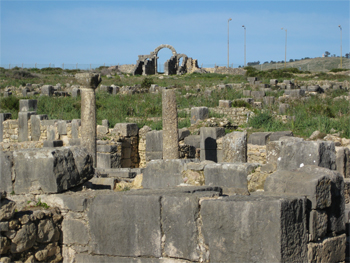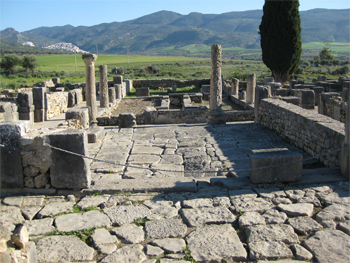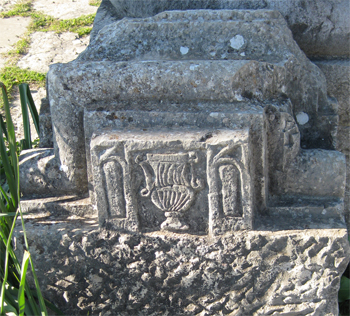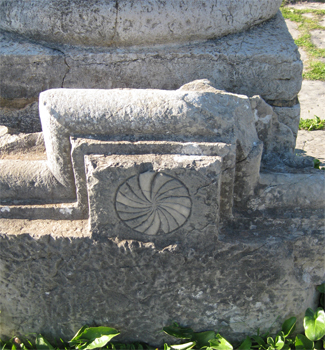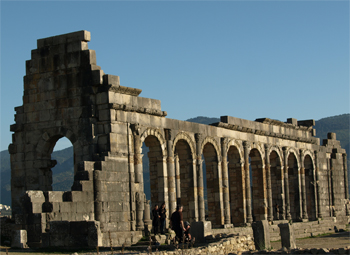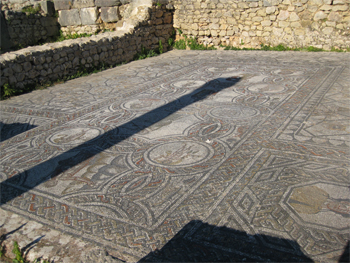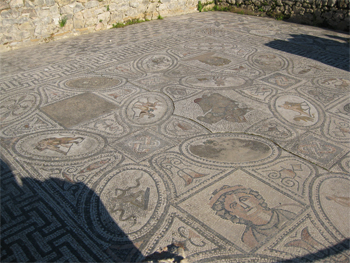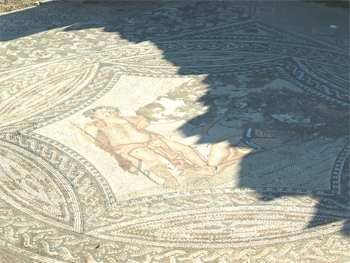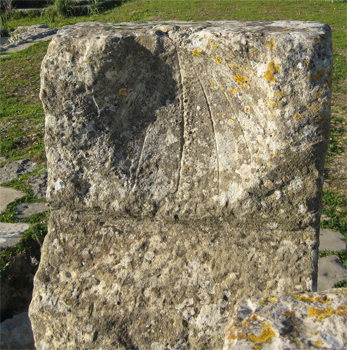Sun., 2/6/11 - Rabat to Volubilis and Fes
On the way out of town we passed the palace in which the present king, Mohamed VI, chooses to live, the barracks and horse stables of the army/guard that protect him, and the mint that prints Moroccan and other African currencies. We then drove through the Maamoura Forest, which is government owned and features cork oak trees. We stopped for a demonstration.
Maamoura Forest |
Cork trees
|
Bark is peeled off of the lower part of the trunk after 25 years of growth and then after every nine years. A tree lives about 250 years. The bark is then laid out in the fields to dry for a year or two. Cork can be used for insulation and bottle stoppers and makes up the explosion pieces in movies scenes. Morocco is the biggest exporter of cork. A disease is killing cork trees in Portugal, so prices have risen and many wineries are switching to rubber stoppers. Wild boars eat the cork acorns - Moslems don't eat pork so there are lots of wild boars in the forest. The forest also has truffles that the boars like. Companies bid to get permission to collect cork from forest sections that are harvestable and the process is government controlled. There are three types of land in Morocco: the forests owned and controlled by the government, farmland held and worked by citizens, and communal land used by groups and for housing.
|
Cork tree with bark removed
|
Market day |
Horse and buggy
|
Cutting food for the donkey
|
We drove all day through beautiful patchworks of green fields. They grow and export wheat and barley, fruits mainly citrus, dates and figs, and nuts especially almonds and, of course, olives. The fishing industry exports sardines, anchovies, tuna, and swordfish. The only industry here is assembly plants mostly for cars from French companies. We stopped at a roadside stand selling eggs, live chickens and turkeys, cardamom, carob, snails, honey, and olive oil. These are made locally by the farmers and sold to people driving by.
|
Green hillsides |
Roadside stand
|
Eggs, vegetables, and snails
|
Fresh fowl |
We arrived in Meknes, which was a capital in the 17th c. King Moulay Ismail chose it because of the fertile land, river, and its central location.
First Gate into the fortified old city
|
Royal reservoir |
|
The king built a reservoir to irrigate his royal garden and to provide drinking water in case of war. He built a huge stone granary that stored wheat for five years of drought, famine, or war. A system of wells and tanks lay below the storage rooms.
|
|
Granary sign |
Granary
|
Access to underground water supply
|
Stables |
The king was influenced by Luis XIV and wanted a palace like Versailles. He had 500 wives and 1500 children. He kept the horses in his army stables saddled and ready to fight. The earthquake of Lisbon in 1755 ruined most of the palace.
We also stopped at the Victorious Gate and strolled across the street through the market with spices, candy, meat, olives, etc.
Victorious Gate |
Tile work and carving
|
Square
|
Market |
Olives |
Meat
|
Meat
|
Sheep heads and cow's feet |
Chickens, eggs, and rabbits
|
Cookies! |
We walked to lunch - another wonderful Moroccan meal with the best tangerines (from Tangiers) I can every remember eating!
|
|
|
Restaurant interior
|
Our next stop was at the ruins on the Roman city of Volubilis outside the town of Moulay Idriss. The city is still being excavated but shows a typical Roman city. There is the Arch to Caligula, a temple to Juniper, Juno, and Minerva, a basilica, the north-south oriented stone main street with the Tanger Gate at the north, and a Triumphal Arch. A drainage ran under the road and a viaduct flowed beside it. Shops lined the main street. Some of the shop identity stones where there on the ground - bakery, wine, fish, chicken, butcher. The patricians lived on the west side of the street and the plebeians to the east. Enemies would approach from the east and attack the common folk first.
Town of Moulay Idriss
|
Ruins of Volubilis |
Tanger gate
|
Ruins of a house |
An aqueduct |
Wine press - over 60 olive presses have been found at this site.
|
Merchant signs - Wine merchant |
Bakery
|
Butcher
|
Triumphal arch |
Triumphal arch
|
Triumphal arch - Latin inscription |
Basilica
|
Basilica |
Mosaics - Four seasons
|
Mosaics - House of Orpheus |
Bacchus and Ariadne on the floor of a knight's house
|
The acrobat |
Sun dial
|
As they uncovered various houses they found courtyards with fountains and baths (in the patricians side) and 15 mosaic floors. One had designs of Diana, the huntress, with Pegasus and nymphs. Another was a design of Helios. These were in dining rooms and the mosaics indicated where the chaises were put so the Romans could lie down to eat. Another tile floor had the portraits of the four seasons, another the twelve labors of Hercules, another bedroom had Bacchus and a drunken man, another floor had an acrobat riding a donkey backwards. The layout of the city also contains the basilica with several of the walls and columns in place, the auditorium and the temple to Jupiter with its 211 AD sacrificial alter. The sun dial was typical Roman. I really enjoyed Volubilis! Links: http://en.wikipedia.org/wiki/Volubilis http://www.kuhmann.com/poetry/Volubilis.htm
|
We entered Fes after 6 PM. Fes was founded by Moors in 808 AD and was the capital for a while. The population grew with Spanish and Tunisian refugees and then Jews in the 14 c. The French arrived in the 17th c. The first university in the world was opened here in 826 AD. Fes is known as the intellectual capital (the most universities for the best and brightest students), the spiritual capital (most mosques), and the handcraft capital of Morocco. Tomorrow we will see some of the crafts. Fes is the city and fez is the hat.
Dinner at the Fes Ramada was an excellent buffet.
